"Order diabecon 60caps overnight delivery, diabetes mellitus retinopathy."
By: Kate Leslie, MB, BS, MD
- Staff Specialist, Head of Anesthesia Research, Royal Melbourne Hospital
- Professor, Department of Anesthesiology, Monash University, Melbourne, Australia
https://research.monash.edu/en/persons/kate-leslie
Characteristic also of the nutritional diseases is the potential for involvement of both the central and peripheral nervous techniques diabetes type 2 journal articles quality 60caps diabecon, an attribute shared only with certain metabolic issues diabetes symptoms dark urine diabecon 60 caps online. Wernicke disease and Korsakoff psychosis (thiamine deficiency) Nutritional polyneuropathy (neuropathic beriberi diabetes diet low gi generic diabecon 60caps, probably related to thaimine deficiency) Deficiency amblyopia (nutritional optic neuropathy; "tobacco-alcohol" amblyopia) Pellagra with remarks on spinal spastic ataxia and encephalopathy [nicotinic acid (niacin) deficiency] the syndrome of amblyopia diabetes type 2 high blood sugar cheap 60 caps diabecon with visa, painful neuropathy, and orogenital dermatitis (so-known as Strachan syndrome) Subacute mixed degeneration of the spinal wire (vitamin B12 deficiency) Neurologic issues because of a deficiency of pyridoxine and probably other B nutritional vitamins (pantothenic acid, riboflavin, folic acid) Inherited issues of vitamin E metabolism eight. In addition, consideration is drawn to several distinctive neurologic issues in which nutritional deficiency may play a role, although this has not been proved: (1) "alcoholic" cerebellar degeneration, Copyright © 2005, 2001, 1997, 1993, 1989, 1985, 1981, 1977, by the McGraw-Hill Companies, Inc. Deficiencies of other important dietary components have been reviewed by Fowden and colleagues. The Wernicke-Korsakoff Syndrome Wernicke disease and the Korsakoff amnesic state are frequent neurologic issues that have been recognized for the reason that 1880s. Wernicke disease (originally known as polioencephalitis hemorrhagica superioris) is characterised by nystagmus, abducens and conjugate gaze palsies, ataxia of gait, and psychological confusion. These symptoms develop acutely or subacutely and will happen singly or, extra often, in various mixtures. Wernicke disease is due specifically to a deficiency of thiamine and is observed primarily although removed from exclusively in alcoholics. The Korsakoff amnesic state (Korsakoff psychosis) is a novel psychological disorder in which retentive reminiscence is impaired out of proportion to all other cognitive capabilities in an otherwise alert and responsive patient. This amnesic disorder, like Wernicke disease, is most frequently related to alcoholism and malnutrition, however it might be a symptom of assorted other diseases which have their basis in lesions of the medial thalami or the inferomedial portions of the temporal lobes, similar to infarction in the territory of the temporal lobe branches of the posterior cerebral arteries, hippocampal damage after cardiac arrest, third ventricular tumors, or herpes simplex encephalitis. A Korsakoff type of reminiscence disturbance may also observe lesions that contain the basal septal nuclei of the frontal lobe. Transient impairments of retentive reminiscence of the Korsakoff type could be the salient manifestations of temporal lobe epilepsy, concussive head harm, and a novel disorder generally known as transient global amnesia. The anatomic basis of the Korsakoff amnesic syndrome is mentioned further in Chap. In the alcoholic, nutritionally deficient patient, Korsakoff amnesia is normally related to and follows the prevalence of Wernicke disease. Stated one other way, Korsakoff psychosis is the psychic manifestation of Wernicke disease. For this purpose and others elaborated beneath, the time period Wernicke disease or Wernicke encephalopathy ought to be utilized to a symptom complicated of ophthalmoparesis, nystagmus, ataxia, and an acute apathetic-confusional state. If an enduring defect in studying and reminiscence is added, the symptom complicated is appropriately designated as the Wernicke-Korsakoff syndrome. Historical Note In 1881, Carl Wernicke first described an sickness of sudden onset characterised by paralysis of eye movements, ataxia of gait, and psychological confusion. His observations had been made in three patients, of whom two had been alcoholics and one was a young lady with persistent vomiting following the ingestion of sulfuric acid. In every of these patients there was progressive stupor and coma, culminating in dying. The pathologic changes described by Wernicke consisted of punctate hemorrhages, primarily affecting the gray matter around the third and fourth ven- tricles and aqueduct of Sylvius; he considered these changes to be inflammatory in nature and confined to the gray matter, hence his designation "polioencephalitis hemorrhagica superioris. In an identical vein, a variety of early writers, beginning with Magnus Huss in 1852, made casual reference to a disturbance of reminiscence in the course of chronic alcoholism. However, the primary complete account of this disorder was given by the Russian psychiatrist S. Korsakoff in a series of articles printed between 1887 and 1891 (for English translation and commentary, see reference by Victor and Yakovlev). Korsakoff confused the relationship between "neuritis" (a time period used at that time for all types of peripheral nerve disease) and the attribute disorder of reminiscence, which he believed to be "two aspects of the same disease" and which he known as "psychosis polyneuritica. His scientific descriptions had been remarkably full and have hardly been surpassed to the current day. It is of interest that the relationship between Wernicke disease and Korsakoff polyneuritic psychosis was appreciated neither by Wernicke nor by Korsakoff. Murawieff, in 1897, first postulated that a single trigger was liable for both. The intimate scientific relationship was established by Bonhoeffer in 1904, who said that in all cases of Wernicke disease he discovered neuritis and an amnesic psychosis.
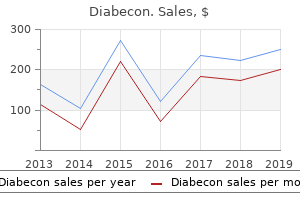
Koeppen and Robitaille diabetes 75 buy discount diabecon 60 caps line, in a current and thorough review of the topic diabetes oatmeal order diabecon 60 caps on line, summarize the present-day understanding of the pathogenesis diabetes recipes proven 60caps diabecon, primarily based on misfolding of myelin proteins diabetes signs in child buy diabecon 60 caps. Unclassifiable Sporadic and Familial Sudanophilic Leukodystrophies There are two types of such disorder, one with early and the other with late onset. In the former, onset is earlier than three months, with survival of less than 2 years; in the latter kind, onset is from three to 7 years and the course is continual. Psychomotor regression; spastic paralysis; incoordination; blindness and optic atrophy; seizures (rare); severe microcephaly; and absence of skeletal, visceral, and hematologic evidence of the metabolic abnormality are the principle options. Rabinowicz, a brother and sister living to adolescence, the destroyed white matter was broadly cavitated. Sudanophilic Leukodystrophies and Pelizaeus-Merzbacher Disease these are a heterogeneous group of disorders that have in frequent a defective myelination of the cerebrum, brainstem, cerebellum, spinal cord, and peripheral nerves. Morphologic peculiarities and genetic options separate a sure group called Pelizaeus-Merzbacher disease; other types have been artificially delineated; as a result, a comparatively meaningless terminology has been introduced. Pelizaeus-Merzbacher Disease this is predominantly an Xlinked disease of infancy, childhood, and adolescence and contains other closely related pathologic entities with totally different modes of inheritance. Koeppen and associates have offered evidence of a defective synthesis of this protein. The onset of signs is most frequently in the first months of life; other cases start later in childhood. The first signs are abnormal actions of the eyes (fast, irregular, often asymmetrical pendular nystagmus), jerk nystagmus on extremes of lateral actions, upbeat nystagmus on upward gaze, and hypometric saccades (Trobe et al). There is spastic weakness of the limbs, optic atrophy (often with unexplained retention of pupillary gentle reflex), ataxia of limb motion and intention tremor, choreiform or athetotic actions of the arms, and sluggish psychomotor development with delay in sitting, standing, and walking. In later-developing cases, pendular nystagmus, choreoathetosis, corticospinal signs, dysarthria, cerebellar ataxia, and psychological deterioration are the main manifestations. There are milder cases of later onset with behavioral peculiarities and lack of tendon reflexes and, hardly ever, pure spastic paraparesis. In probably the most severe cases, Seitelberger has noticed an absence of oligodendrocytes and myelinated fibers. It is hypothesized that proteolipids accumulate in the endoplasmic reticulum of the oligodendrocytes, resulting in apoptosis. One group of cases resembles the Cockayne syndrome (page 824), with photosensitivity of skin, dwarfism, cerebellar ataxia, corticospinal signs, cataracts, retinitis pigmentosa, and deafness. Pathologically, islands of preserved myelin impart a tigroid sample of degenerated and Spongy Degeneration of Infancy (Canavan-van Bogaert-Bertrand or Canavan Disease) this is an autosomal recessive disease described in 1931 by Canavan as a type of Schilder disease (see Chap. Onset is early, normally recognizable in the first three months of life and sometimes in the first neonatal weeks. There is either a lack of development or fast regression of psychomotor function, lack of sight and optic atrophy, lethargy, difficulty in sucking, irritability, lowered motor exercise, hypotonia followed by spasticity of the limbs with corticospinal signs, and an enlarged head (macrocephaly). An attention-grabbing however unexplored aspect of the disease is the incidence of blond hair and light-weight complexion in affected members, in contrast to the darker hair and complexion of their regular siblings (Banker and Victor). Instead, after a long interval of constipation, sleep disorder, and orthostatic hypotension throughout adolescence, bulbar signs (dysarthria, dysphonia, and dysphagia), seizures, and in some cases ataxia steadily emerged throughout adult years. Alpers Disease this can be a progressive disease of the cerebral grey matter, known also as progressive cerebral poliodystrophy or diffuse cerebral degeneration in infancy. A familial form (most likely autosomal recessive) as properly many sporadic cases has been reported. In some cases, the late onset of jaundice and fatty degeneration or cirrhosis of the liver have been described (Alpers-Huttenlocher syndrome); the hepatic modifications are distinctive and possibly not related to the use of anticonvulsant medication, as had been hypothesized (Harding et al). The nature of this mixed hepatic-cerebral degeneration remains unexplained, however some cases have been related to the mitochondrial disorders, as noted below. Neuropathologic examination exhibits marked atrophy of the cerebral convolutions and cerebellar cortex, with lack of nerve cells and fibrous gliosis ("walnut mind"). In some cases, the spongiform vacuolization of the grey matter of the mind resembles that seen in Creutzfeldt-Jakob disease. Hypoglycemic, hypoxic, and hypotensive encephalopathies must all the time be considered in the diagnosis however can normally be eliminated by data of the scientific circumstances on the onset of the illness. A variety of biochemical abnormalities have been recognized in sufferers with Alpers disease, together with pyruvate dehydrogenase deficiency, decreased pyruvate utilization, dysfunction of the citric acid cycle, and decreased cytochromes a and aa3. The biochemical and pathologic modifications counsel a relationship to Leigh encephalomyelopathy and a mitochondrial transmission. Many authoritative texts classify it with the mitochondrial ailments, however its nosologic standing is in our opinion still uncertain (see Shaffner and Wallace).
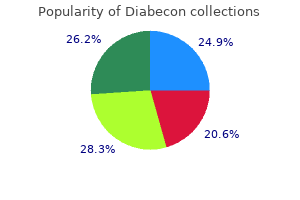
The illness had its onset in early grownup life and was characterized by progressive ataxia of gait diabetes xtc cheap 60 caps diabecon free shipping, adopted by dysarthria diabetes in dogs and pancreatitis cheap diabecon 60 caps fast delivery, nystagmus diabetes test during pregnancy what week diabecon 60caps fast delivery, slowness of eye movements blood sugar 71 discount 60 caps diabecon with mastercard, decreased facial mobility, slow lingual movements, fasciculations of face and tongue, dystonic postures, rigidity of the limbs, cerebellar tremor, hyperreflexia, and Babinski signs. Under the name Azorean illness of the nervous system (now higher often known as Machado-Joseph illness), Romanul and colleagues described one more household of Portuguese-Azorean descent, many members of which were affected by a syndrome comprising a progressive ataxia of gait, parkinsonian options, limitation of conjugate gaze, fasciculations, areflexia, nystagmus, ataxic tremor, and extensor plantar responses; the pathologic modifications intently resembled those described by Woods and Schaumburg. Romanul and coworkers compared the genetic, medical, and pathologic options of their circumstances with those described in other Portuguese-Azorean families and concluded that all of them represent a single genetic entity with variable expression. This idea of the illness has been corroborated by the further observations of Rosenberg and of Fowler, who studied 20 sufferers with the Machado-Joseph-Azorean illness over a ten-12 months interval. Cases conforming to the above descriptions have now been noticed amongst AfricanAmerican, Indian, and Japanese families (Sakai et al, Yuasa et al, Bharucha et al). Early analysis of sufferers at risk is possible by the examination of ocular movements. In asymptomatic sufferers, Hotson and associates found dysmetric horizontal and vertical saccades much like those in symptomatic people. Multiple System Atrophy with Predominant Ataxia (See web page 925) this entity has been mentioned with the degenerative disorders of the basal ganglia earlier in the chapter. The extrapyramidal, corticospinal, or autonomic features of the sickness turn into evident only with continued observe-up or by pathologic examination. The major consideration when chorea is outstanding is the separation of this disorder from Huntington illness (Warner et al). As with Huntington chorea (the place the expanded polyglutamine tract is in huntingtin), this illness is inherited as an autosomal dominant trait and reveals an inverse correlation between the age of onset and the dimensions of the gene expansion. Pollock and Kies have described one more late-life type of hereditary cerebellar ataxia with near global loss of ache and temperature sensation (because of loss of major sensory afferents). Details relating to these uncommon ataxias and acceptable references can be found in the monograph on the inherited ataxias edited by Kark et al. Paroxysmal Ataxias Two grownup forms of hereditary cerebellar ataxia are paroxysmal in nature (see Chap. Between attacks the patient is regular or has only minimal ataxia and nystagmus (Griggs et al). The disorder has been found to be a disorder of the calcium channel on chromosome 19. The disorder is because of an abnormality of the potassium channel gene on chromosome 12. In 1921, Ramsay Hunt published an account of 6 sufferers (2 of whom were twin brothers) in whom myoclonus was mixed with progressive cerebellar ataxia. The age of onset in the 4 nonfamilial circumstances was between 7 and 17 years, and the cerebellar ataxia adopted the myoclonus by an interval of 1 to 20 years. In the twin brothers there have been signs of Friedreich ataxia; postmortem examination of 1 showed a degeneration of the posterior columns and spinocerebellar tracts but not of the corticospinal tracts. The only lesion in the cerebellum was an atrophy and sclerosis of the dentate nuclei with degeneration of the superior cerebellar peduncles. Louis-Bar and van Bogaert in 1947 reported a similar case, and they famous, in addition to the above findings, degeneration of the corticospinal tracts and loss of fibers in the posterior roots. Thus the pathology was similar to that of Friedreich ataxia apart from the extra extreme atrophy of the dentate nuclei. Earlier (1914), under the title of dyssynergia cerebellaris progressiva, Hunt had drawn consideration to a progressive illness in younger people manifest by what he considered to be a pure cerebellar syndrome. One of the three sufferers described in this paper died thirteen years after the onset of her sickness. Necropsy disclosed cavitary lesions in the lenticular nuclei, cerebellum, and pons and a diffuse enhance of Alzheimer (sort 2) glial cells, associated with asymptomatic nodular cirrhosis of the liver- i. Cerebellar Ataxia with Selective Degeneration of Other Systems In addition to those enumerated earlier on web page 185), Genetics of the Heredodegenerative Ataxias (Table 39-5) the various familial degenerative ataxic disorders described in the preceding pages are genetically distinct. The rarer recessive sort related Ё with vitamin E deficiency arises from mutations in the gene that encodes an alpha tocopherol (vitamin E) transport protein, as talked about above. Among the autosomal dominant cerebellar ataxias of later onset, molecular and gene research have identified mutant genes at 14 chromosomal loci, together with three associated with episodic ataxia. However, as has been affirmed, the precise mechanisms by which the expanded polyglutamine molecule results in neuronal cell dying stay unsure.
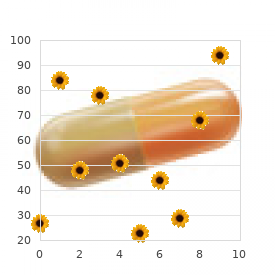
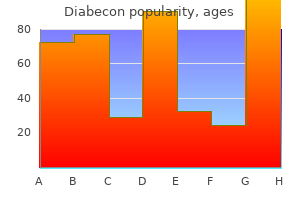
Other sufferers imagine that ideas have been implanted in their minds by some exterior agency diabetes in dogs side effects of insulin cheap diabecon 60caps amex, such because the Internet diabetes warning signs in toddlers buy diabecon 60 caps lowest price, radio type 2 diabetes medications side effects cheap 60 caps diabecon, tv blood sugar normal range chart buy 60 caps diabecon overnight delivery, or atomic vitality; these "passivity emotions" are highly characteristic of schizophrenia and sometimes of manic illness. Also diagnostic of schizophrenia are distortions of logical thought, corresponding to gaps in sequential considering, intrusion of irrelevant ideas, and condensation of associations. The normally risky, cyclothymic particular person is alleged to be liable to manic-depressive illness, and the suspicious, withdrawn, introverted particular person to schizophrenia and paranoia, however there are frequent exceptions to this assertion. Strong, persistent emotional states, corresponding to worry and anxiousness, could happen as reactions to life conditions and may be accompanied by derangements of visceral operate. Emotional responses which are excessively labile and poorly controlled or uninhibited are a standard manifestation of many cerebral diseases, significantly those involving the corticopontine and corticobulbar pathways. This disorder constitutes part of the syndrome of spastic bulbar (pseudobulbar) palsy (pages 426, 445 and 450), however they could happen at times independently of any problem with brainstem operate. Conversely, all emotional feeling and expression may be missing, as in states of profound apathy or severe melancholy. Or extreme cheerfulness may be maintained within the face of great, doubtlessly deadly illness or other adversity; a pathologic euphoria. By temper is meant the prevailing emotional state of a person irrespective of the stimuli instantly impinging upon him. As reported by the affected person when queried, it may be cheerful and optimistic or gloomy and melancholic. By distinction, have an effect on (or feeling) refers to the emotional reactions evoked by a thought or an environmental stimulus. According to some psychiatrists, feeling is the subjective component and have an effect on is the overt manifestation of emotion. For example, a dissociation of temper and have an effect on is characteristic of the aforementioned pseudobulbar state by which the affected person shows extremes of easily precipitated and surprising crying or laughing while reporting only slight alterations in subjective emotion. The emotional disturbances referring to neurological illness are mentioned extra fully in Chap. Disorders of these parts of the motor system intervene with voluntary or automatic movements, a lot to the misery of the affected person. But motility and exercise may be impaired for other reasons, certainly one of which is a lack of conation or impulse. These phrases designate that fundamental biologic urge, driving force, or objective by which each organism is motivated to achieve an endless sequence of aims. Indeed, motor exercise is a necessary and satisfying objective in itself, for few people can remain nonetheless for lengthy (fidgets, doodling), and even the severely retarded obtain Disturbances of Emotion, Mood, and Affect the emotional life of the affected person is expressed in a variety of ways. In the primary place, quite marked individual differences in fundamental temperament are noticed within the regular inhabitants; some persons are all through their lives cheerful, gregarious, optimistic, and free from fear, whereas others are just the alternative. An necessary aspect of this state, known as abulia, is the concomitant discount in movement, speech, ideation, and emotional reaction (apathy). It is well-known that people vary greatly in strength of impulse, drive, and vitality. Some are born low in impulse, with a lifelong tendency to inactivity, a constitutional inadequacy that Kahn known as asthenic psychopathy; others are excessively energetic from adolescence. Such sufferers appear detached to what is happening around them and unconcerned concerning the penalties of their inactivity. Abulia and akinetic mutism must be distinguished from two allied states, catatonia and the psychomotor retardation of melancholy. Kahlbaum, who first used the term catatonia in 1874, described it as a condition by which the affected person sits or lies silent and immobile, with a staring countenance, completely without volition and without reaction to sensory impressions. Profound melancholy or psychopathy are the usual causes of catatonia (see pages 306 and 1311). The psychomotor retardation of melancholy may be so profound that the affected person makes no try to help himself in any way and finally starves unless fed with a nasogastric tube. The whispering speech and demeanor of such depressed sufferers categorical their sadness and want to die.
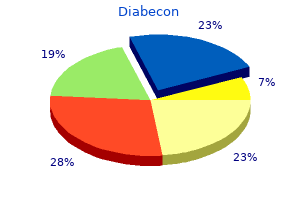
Epidemic typhus is an exception diabetes prevention lifestyle coach training 60 caps diabecon with amex, involving only lice and human beings diabetes prevention control and alliance purchase diabecon 60caps online, and Q fever might be contracted by inhalation blood glucose strips buy generic diabecon 60caps on-line. At the time of the First World War diabetes prevention cost effectiveness discount 60 caps diabecon with mastercard, the rickettsial diseases, typhus specifically, have been remarkably prevalent and of the utmost gravity. In eastern Europe, between 1915 and 1922, there have been an estimated 30 million cases of typhus with 3 million deaths. In the United States these diseases are quite rare, but they assume significance as a result of, in some types, as much as one-third of sufferers have neurologic manifestations. About 200 cases of Rocky Mountain spotted fever (the commonest rickettsial disease) happen annually in the United States, with a mortality of 5 % or less. Neurologic manifestations happen in a small portion, and neurologists may not encounter a single instance in a lifetime of practice. Murine (endemic) typhus, which is current in the same areas as Rocky Mountain spotted fever (see under). Scrub typhus or tsutsugamushi fever, which is confined to eastern and southeastern Asia. Rocky Mountain spotted fever, first described in Montana, is commonest in Long Island, Tennessee, Virginia, North Carolina, and Maryland. Q fever, which has a worldwide distribution (apart from the Scandinavian countries and the tropics). It is transmitted in nature by ticks but in addition by inhalation of mud and handling of supplies infected by the causative organism, Coxiella burnetii. With the exception of Q fever, the clinical manifestations and pathologic effects of the rickettsial diseases are much the same, varying only in severity. The onset is usually abrupt, with fever rising to extreme ranges over several days; headache, usually extreme; and prostration. A macular rash, which resembles that of measles and involves the trunk and limbs, appears on the fourth or fifth febrile day. An necessary diagnostic check in scrub typhus is the necrotic ulcer and eschar on the website of attachment of the infected mite. Delirium- adopted by progressive stupor and coma, sustained fever, and sometimes focal neurologic indicators and 1. In deadly cases, the rickettsial lesions are scattered diffusely throughout the brain, affecting grey and white matter alike. The modifications include swelling and proliferation of endothelial cells of small vessels and a microglial response, with the formation of so-referred to as typhus nodules. Rare situations of encephalitis, cerebellitis, and myelitis are also reported, presumably as postinfectious issues. There is usually a tracheobronchitis or atypical pneumonia (one by which no organism can be cultured from the sputum) and a extreme prodromal headache. In these respects, the pulmonary and the neurologic sickness resembles that of the opposite primary explanation for "atypical pneumonia," M. The Q fever agent (Coxiella) ought to be suspected if there are concomitant respiratory and meningoencephalitic sicknesses and there was exposure to parturient animals, to livestock (including abattoir employees), or to wild deer or rabbits. The diagnosis can be made by the discovering of a severalfold increase in particular immunofixation antibodies. Patients who survive the sickness usually recuperate fully; a couple of are left with residual neurologic indicators. Treatment this consists of the administration of chloramphenicol or tetracycline, which are extremely effective in all rickettsial diseases. If these medication are given early, coincident with the appearance of the rash, signs abate dramatically and little further remedy is required. Cases acknowledged late in the middle of the disease require considerable supportive care, including the administration of corticosteroids, upkeep of blood quantity to overcome the consequences of the septic-toxic response, and hypoproteinemia. Congenital an infection is the results of parasitemia in the mom who occurs to be pregnant on the time of her initial (asymptomatic) Toxoplasma an infection. The congenital an infection has attracted consideration due to its extreme harmful effects on the neonatal brain, as mentioned in Chap. Signs of energetic an infection- fever, rash, seizures, hepatosplenomegaly- may be current at delivery. More usually, chorioretinitis, hydrocephalus or microcephaly, cerebral calcifications, and psychomotor retardation are the most important manifestations.
Cheap 60caps diabecon fast delivery. Mieux gérer son diabète au quotidien.
References:
- https://www.jusurgery.com/universalsurgery/role-of-ankle-brachial-index-abi-in-management-of-nonhealing-ulcers-of-lower-limb.pdf
- https://pdfs.semanticscholar.org/18cd/3dde3cb034019f002b01ab4a1766f50a3b76.pdf
- https://phpa.health.maryland.gov/IDEHASharedDocuments/MONONUCLEOSIS.pdf
- https://www.rxabbvie.com/pdf/mavyret_pi.pdf
- https://www.uwmedicine.org/sites/default/files/2018-11/Transplant-Kidney-and-Pancreas-Transplant-Guide.pdf

